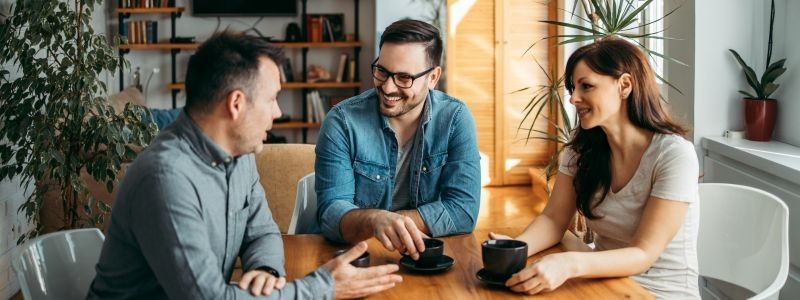
Head of Online Medical Content

Audiology Expert at Hearing Aid UK

What is Mild Hearing Loss?
Why mild hearing loss isn't harmless and shouldn't be ignored
Overview | Causes of mild hearing loss | How does mild hearing loss affect you? | Treatments for mild hearing loss | Can you prevent mild hearing loss? | Mild hearing loss diagnosis | Can mild hearing loss be corrected?
Mild hearing loss involves difficulty hearing soft sounds and understanding speech in noisy environments. It typically affects hearing thresholds between 26 to 40 decibels. Common causes include ageing, noise exposure, and ear infections. Treatment options include hearing aids and assistive devices to improve sound clarity and communication.
In this article, we explore the causes, effects, and available treatment options for mild hearing loss, which we hope will shed light on this often-overlooked level of hearing loss.
Fake it until you make it
Hearing loss is separated into levels of severity from mild to profound. If you have mild hearing loss, your loss is not classed as severe, which means that you may be inclined to take on the “fake it until you make it” approach. Here lies the danger, because the loss is mild, it can be more subtle than obvious. Thus making it easier to disregard.

What is mild hearing loss? What is the mild hearing loss range?
Mild hearing loss is a relatively common auditory impairment that affects a significant portion of the UK’s population. While it is not considered as severe as profound hearing loss, mild hearing loss can still have a noticeable impact on quality of life.
For example, it can be a barrier to communication at home and in the office, as well as affect overall health and well-being.
When we take a look at mild hearing impairment characteristics, it typically affects sounds that are quieter than 25 db (decibels). Those with mild hearing loss often struggle to hear soft or distant sounds, as well as find it challenging to understand speech in noisy environments and within conversations on the phone.
So, what does mild hearing loss sound like?
If you have mild hearing loss, you may also struggle with high and low-frequency sounds. In fact, most people lose the ability to hear high-frequency sounds first. Those with this level of hearing loss often complain that although they can hear conversations, they can’t actually fully understand them.
Is mild hearing loss normal? Yes, mild hearing loss can be considered within the range of normal variations in hearing ability. Many people experience mild hearing loss as they age or because of other factors such as noise exposure or genetics.
While it may not significantly impact daily functioning for some, others may benefit from interventions and treatments such as hearing aids.
Mild hearing loss causes
What are the causes of mild hearing loss? There can be various causes of mild hearing loss, including genetics, exposure to loud noises, ageing (presbycusis), certain medications (ototoxicity), infections, and medical conditions like otosclerosis or Meniere's disease. It is important to identify and address such causes, as some may be reversible or treatable.
The earlier the diagnosis, the higher the success rate for effective hearing healthcare treatment in the future.

The effects of mild hearing loss
Is mild hearing loss bad?
How does mild hearing loss affect the quality of life?
Mild hearing loss can significantly impact your ability to communicate and overall quality of life. It may lead to misunderstandings, increased effort to understand speech, social isolation, and resistance to attending social gatherings and enjoyable activities.
In social settings, those with mild hearing loss may struggle to follow conversations, which can lead to feeling frustrated, reduced confidence, and ultimately affect mental health. In professional settings, mild hearing loss can affect job performance, restrict communication with colleagues, and hinder career advancement.
It may also strain personal relationships, as communication slowly breaks down, leading to misunderstandings and strained interactions with family and friends.
What are the treatments for mild hearing loss? Can mild hearing loss be reversed?
Fortunately, there are several treatment options available for those with mild hearing loss. The most common and effective solution is hearing aids. Modern hearing aids are technologically advanced devices that can amplify sounds, improve speech understanding and offer hearing personalisation.
They come in various styles, including Behind-the-Ear (BTE), In-the-Ear (ITE), Receiver-in-Canal (RIC), and other types, offering options that suit preferences, needs, and hearing loss levels.
Can you prevent mild hearing loss?
The most preventable type of hearing loss is noise-induced hearing loss (NIHL). This is a condition that affects millions in the UK. However, many types of hearing protective devices are available to help you keep your hearing safe from noise-induced hearing loss. These are:
- Foam earplugs: These earplugs are ideal for basic noise prevention.
- In-ear monitors: These are custom-made devices for musicians to protect their hearing and control the amount of sound they hear from each instrument.
- Filtered earplugs: These are great for music lovers who want to enjoy a concert without affecting the fidelity of sound.
- Percussive filters: These are custom moulded for those who enjoy shooting sports.
Mild hearing loss diagnosis
How is mild hearing loss diagnosed? Diagnosing mild hearing loss typically involves a thorough hearing evaluation conducted by an audiologist. The process begins with a discussion of your medical history and any concerns related to hearing ability in general.
The audiologist will then perform a series of tests, such as pure-tone audiometry, where you listen to tones at various frequencies and volumes.
The results are plotted on an audiogram, which helps determine the degree and type of hearing loss. Speech audiometry may also be conducted to assess the ability to understand and repeat words. Through these tests, an audiologist can accurately diagnose mild hearing loss and provide appropriate recommendations for management and treatment going forward.

Looking at mild hearing loss and hearing aids
What are the best hearing aids for mild hearing loss?
Can mild hearing loss be corrected?
There is good news: those who have mild hearing loss are generally great candidates for hearing aids. Hearing aid technology is more advanced than ever, aesthetically subtle, and supports all degrees of hearing loss. Even though mild hearing loss is not as severe as profound hearing loss, it is still significant.
This is why recognising and understanding the signs of mild hearing loss is important. Seeking early diagnosis and exploring appropriate treatment options can increase the effectiveness of how mild hearing loss is managed.
With advancements in hearing aid technology, people with mild hearing loss can regain their ability to engage in conversations, improve their quality of life, and enjoy a more fulfilling listening experience.
Why Choose Us?
- FREE Hearing Tests
- Best Hearing Aids and Prices
- FREE Aftercare for Life
- FREE Home Visits
- 200+ Local Audiologists
- 60 Day Money Back Guarantee
Should mild hearing loss be treated?
Recognising and understanding the signs of mild hearing loss is important
Seeking early diagnosis and exploring appropriate treatment options can increase the effectiveness of how mild hearing loss is managed.
If you suspect you or a loved one may have mild hearing loss, consulting with an audiologist is the first step toward better hearing health.
Call us free on 0800 567 7621 to speak with one of our team.
Other hearing loss awareness articles you might like...
 I have difficulty hearing in noisy places
I have difficulty hearing in noisy places  High-Pitched Sounds Like Birdsong Are Fading. Do I Have Hearing Loss?
High-Pitched Sounds Like Birdsong Are Fading. Do I Have Hearing Loss?  Asking people to repeat themselves frequently. Do I have hearing loss?
Asking people to repeat themselves frequently. Do I have hearing loss? What's included in our hearing aid prices?
Our specialist service includes:
Do not spend hundreds of pounds without getting a second opinion from us.
Please call us on 0800 567 7621
 Not only are the prices great, but the service is fantastic! Many thanks to your team.
Not only are the prices great, but the service is fantastic! Many thanks to your team.Common FAQs about hearing aids and hearing loss
If you are looking at this page then it is likely that an audiologist has suggested that you purchase this particular hearing aid, so is this the best model for you?
In general, any audiologist will always recommend to you the model that best suits your needs. Here is a useful checklist to make sure that is the case.
- Audiologist level of knowledge: The audiologist you have seen will hopefully have a wide knowledge of all available hearing aids, however, some will only be familiar with a small number of brands and therefore may not really be in a position to know which model is the best for you. It is OK to challenge their recommendation and ask them to justify why this particular brand is the one for you.
- Do research: Read about the hearing aid that was recommended. Does it seem like it will suit your lifestyle? Does it have more or fewer features than you need?
- Be aware of sales targets: Many high street retailers have specific tie-ins to a particular manufacturer/brand. The hearing aid they have suggested may still be the correct one for you, but do your research so that you know why they might have recommended it.
If in doubt, feel free to give us a call. That's what we're here for. In the meantime, read all about our review of the best hearing aids for 2025 here
If you have significant hearing loss in both ears, you should be wearing two hearing aids. Here are the audiological reasons why:
Localisation: The brain decodes information from both ears and compares and contrasts them. By analysing the minuscule time delays as well as the difference in the loudness of each sound reaching the ears, the person is able to accurately locate a sound source. Simply put, if you have better hearing on one side than the other, you can't accurately tell what direction sounds are coming from.
Less amplification is required: A phenomenon known as “binaural summation” means that the hearing aids can be set at a lower and more natural volume setting than if you wore only one hearing aid.
Head shadow effect: High frequencies, the part of your hearing that gives clarity and meaning to speech sounds, cannot bend around your head. Only low frequencies can. Therefore if someone is talking on your unaided side you are likely to hear that they are speaking, but be unable to tell what they have said.
Noise reduction: The brain has its own built-in noise reduction which is only really effective when it is receiving information from both ears. If only one ear is aided, even with the best hearing aid in the world, it will be difficult for you to hear in background noise as your brain is trying to retain all of the sounds (including background noise) rather than filtering it out.
Sound quality: We are designed to hear in stereo. Only hearing from one side sounds a lot less natural to us.
Fancy some further reading on this topic? You can read about why two hearing aids are better than one in our article, hearing aids for both ears, here
For most people, the main benefit of a rechargeable hearing aid is simple convenience. We are used to plugging in our phones and other devices overnight for them to charge up. Here are some other pros and cons:
For anybody with poor dexterity or issues with their fingers, having a rechargeable aid makes a huge difference as normal hearing aid batteries are quite small and some people find them fiddly to change.
One downside is that if you forget to charge your hearing aid, then it is a problem that can't be instantly fixed. For most a 30-minute charge will get you at least two or three hours of hearing, but if you are the type of person who is likely to forget to plug them in regularly then you're probably better off with standard batteries.
Rechargeable aids are also a little bit bigger and are only available in Behind the Ear models.
Finally, just like with a mobile phone, the amount of charge you get on day one is not going to be the same as you get a few years down the line. Be sure to ask what the policy is with the manufacturer warranty when it comes to replacing the battery.
Looking for more information on rechargeable hearing aids? Read our dedicated page on the topic here
For most people, the answer is yes. But it's never that simple.
The majority of hearing problems affect the high frequencies a lot more than the low ones. Therefore open fitting hearing aids sound a lot more natural and ones that block your ears up can make your own voice sound like you are talking with your head in a bucket. Therefore in-ear aids tend to be less natural.
However the true answer is we can't tell until we have had a look in your ears to assess the size of your ear canal, and until we have tested your hearing to see which frequencies are being affected.
People with wider ear canals tend to have more flexibility, also there are open fitting modular CIC hearing aids now that do not block your ears.
There is also the age old rule to consider, that a hearing aid will not help you if it's sat in the drawer gathering dust. If the only hearing aid you would be happy wearing is one that people can't see, then that's what you should get.
Most people can adapt to any type of hearing aid, as long as they know what to expect. Have an honest conversation with your audiologist as to what your needs are.
Generally speaking, six or more. Unless it's none at all.
The number of channels a hearing aid has is often a simplistic way an audiologist will use to explain why one hearing aid is better than another, but channels are complex and it is really not that straightforward. Here are some reasons why:
Hearing aids amplify sounds of different frequencies by different amounts. Most people have lost more high frequencies than low and therefore need more amplification in the high frequencies. The range of sounds you hear are split into frequency bands or channels and the hearing aids are set to provide the right amount of hearing at each frequency level.
Less than six channels and this cannot be done with much accuracy, so six is the magic number. However, a six channel aid is typically very basic with few other features and is suitable only for hearing a single speaker in a quiet room. The number of channels is not what you should be looking at, it's more the rest of the technology that comes with them.
As a final note, different manufacturers have different approaches. One method is not necessarily better than any other. For example, some manufacturers have as many as 64 channels in their top aids. Most tend to have between 17 and 20. One manufacturer has no channels at all.
Hearing aids are easily lost, misplaced or damaged and typically are one of the most expensive personal possessions an individual can own. We offer hearing aid warranty coverage for £80 per year per aid. Find out more about this service we provide here
All our audiologists use the very latest technology and provide the full range of tests to accurately measure your hearing for free. Find out about what hearing healthcare services we offer all our customers here
Hearing Aid UK offers all their customers free home visiting services, even in a care home environment, for no extra cost. Including hearing tests, fittings, maintenance, check-ups and much more in the comfort of your own home and at your convenience. Find out more information about our home visits here
Here, at Hearing Aid UK, we are dedicated to offering low hearing aid prices. We achieve this by having no head office and low marketing costs. Our hearing aid prices are amongst the lowest you will find anywhere in the world. Explore our prices, brands, and models here
Ask the Experts
6 Morton Lane
Walkwood
Redditch
Worcestershire
B97 5QA
Latest Launch
When we refer to a product as 'Latest Launch', we mean it is the latest to be released on the market.
New
When we refer to a product as 'New', we mean that the product is the newest hearing aid model on the market.
When we refer to a product as 'Superseded', we mean that there is a newer range available which replaces and improves on this product.
Older Model
When we refer to a product as an 'Older Model', we mean that it is has been superseded by at least two more recent hearing aid ranges.
